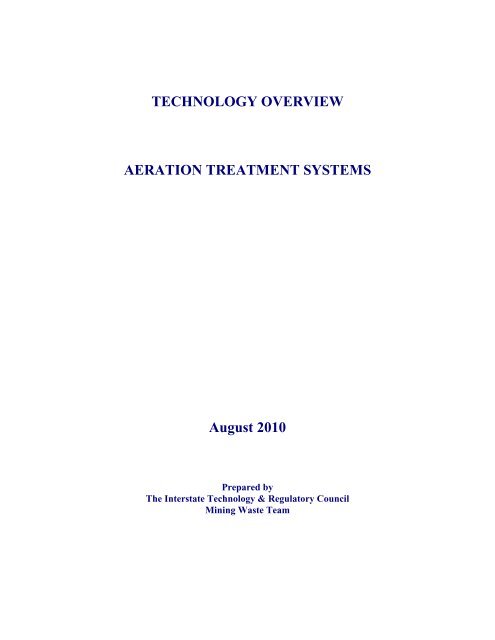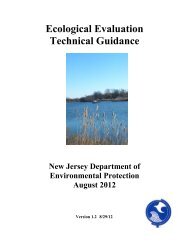TECHNOLOGY OVERVIEW AERATION TREATMENT ... - ITRC
TECHNOLOGY OVERVIEW AERATION TREATMENT ... - ITRC
TECHNOLOGY OVERVIEW AERATION TREATMENT ... - ITRC
You also want an ePaper? Increase the reach of your titles
YUMPU automatically turns print PDFs into web optimized ePapers that Google loves.
<strong>TECHNOLOGY</strong> <strong>OVERVIEW</strong><strong>AERATION</strong> <strong>TREATMENT</strong> SYSTEMSAugust 2010Prepared byThe Interstate Technology & Regulatory CouncilMining Waste Team
Permission is granted to refer to or quote from this publication with the customaryacknowledgment of the source. The suggested citation for this document is as follows:<strong>ITRC</strong> (Interstate Technology & Regulatory Council). 2010. Aeration Treatment Systems.Washington, D.C.: Interstate Technology & Regulatory Council, Mining Waste Team.www.itrcweb.org.
TABLE OF CONTENTS1. INTRODUCTION......................................................................................................................12. APPLICABILITY ......................................................................................................................13. ADVANTAGES ........................................................................................................................24. LIMITATIONS ..........................................................................................................................25. PERFORMANCE ......................................................................................................................26. COSTS .......................................................................................................................................37. REGULATORY CONSIDERATIONS .....................................................................................38. STAKEHOLDER CONSIDERATIONS ...................................................................................39. LESSONS LEARNED ...............................................................................................................410. CASE STUDIES ........................................................................................................................411. REFERENCES ..........................................................................................................................4LIST OF TABLESTable 10-1. Case study that includes aeration technology .............................................................4i
<strong>AERATION</strong> <strong>TREATMENT</strong> SYSTEMS1. INTRODUCTIONThe reduction of dissolved metals concentrations in mining-influenced water (MIW) is typicallya key component in cleanup and management strategies at current and former mine sites.Aeration is an active water treatment process component used to enhance reduction of certaindissolved metals concentrations in MIW under specific geochemical conditions. Aeration is oftenapplied in conjunction with acid-neutralizing agents (lime, limestone, caustic soda, soda ash),chemical oxidants (ozone, sodium hypochlorite, hydrogen peroxide, potassium permanganate),flocculants, filtration, and settling basins.Aeration involves the mechanical introduction of oxygen into the MIW stream through a varietyof techniques with the goal of oxidizing dissolved metals species into less soluble forms.Aeration uses gravity and/or mechanical devices to increase the concentration of dissolvedoxygen in MIW, promoting oxidation of iron, manganese, arsenic, and other problematic metalsspecies, increasing treatment effectiveness and efficiency, and decreasing remediation costs.A variety of aeration technologies exist, ranging from simple gravity-driven cascading flumes toin-line systems that use Venturi-based jet pumps to inject oxygen into the MIW (INAP 2009).Aeration is commonly applied simultaneously with addition of lime and flocculant to increasepH, oxidize metals species, and precipitate metal hydroxides that are then treated throughsettlement, filtering, or other processes.2. APPLICABILITYAeration is applicable to the following situations:• MIW discharge containing elevated dissolved metals concentrations, with low naturaldissolved oxygen• wide variety of sites suitable for active treatment technologies• wide range of flow conditions• used in conjunction with other metals and neutralization treatment technologiesAeration is most commonly used for the treatment of MIW containing levels of dissolved metalsthat exceed regulatory or risk-based water quality standards. MIW often has low pH and lowdissolved oxygen content and may contain elevated carbon dioxide (CO 2 ). In addition MIWcommonly contains elevated levels of iron (Fe 2+ ), manganese (Mn 2+ ), and other metals that aremobile as dissolved constituents. The introduction of dissolved oxygen through aeration resultsin oxidation of the metals species into less soluble forms. Where elevated levels of CO 2 arepresent in MIW, aeration reduces the dissolved CO 2 content, thereby increasing the pH.Aeration techniques can be engineered to treat a wide range of flow conditions, including siteswith very high flow rates and sites with highly variable flow rates. The website atwww.gardguide.com/index.php/Aeration_systems_for_treating_CMD (INAP 2009) providesexamples of various techniques for application of aeration with and without other treatment.
<strong>ITRC</strong> – Permeable Reactive Barrier Systems August 20103. ADVANTAGESThe advantages of aeration include the following:• simplicity and effectiveness of the fundamental geochemical process• application flexibility• the use of air as the treatment reagent• wide range of site conditions• wide range of flow conditionsOxidation reactions are straightforward and readily occur when oxygen is introduced into lowoxygenMIW containing reduced metals species. Mechanical aeration is an effective andrelatively inexpensive method for introducing oxygen. Depending on the contaminants beingaddressed, pH adjustment may be necessary in addition to aeration to achieve the desiredoxidation reaction.Aeration technologies can be adapted to a wide range of site conditions, making them suitable forremote sites as well as active and/or easily accessible mine sites. Aeration most commonly usesatmospheric air as the treatment reagent, avoiding the permitting, management, handling, anddisposal issues that may apply to other chemical reagents.4. LIMITATIONSAeration introduces oxygen into MIW and is, therefore, applicable to sites with MIW dischargecontaining elevated, dissolved, reduced metals species concentrations with low natural dissolvedoxygen. Sites where MIW has relatively high oxygen content will not benefit appreciably fromaeration technologies. Aeration has use as a sole remediation technology in limited situations, butis much more commonly applied in conjunction with other technologies.5. PERFORMANCENo performance data specific to aeration technologies were identified for this technologyoverview. Aeration is sometimes applied alone but is most commonly applied in conjunctionwith other treatment technologies to achieve regulatory or risk-based water quality standards. Anexample system described by EPA (2004) is the In-Line Aeration and Neutralization System,which uses a jet pump or eductor to entrain the air and alkaline chemical by Venturi action and astatic mixer. Sodium hydroxide or sodium carbonate is added to the MIW with aeration to createflocculation. The flocculant is directed through a static mixer, to a clarifier, and then to settlingponds.At the Leviathan Mine Case Study in California, a proprietary technology, Rotating CylinderTreatment System (RCTS), was used to treat MIW drainage overflows from containment pondson site during high spring runoff conditions at a rate of 30–300 gallons per minute. The MIWwas acidic and contained high concentrations of sulfate and metals, including aluminum, arsenic,cadmium, copper, iron, manganese, nickel, selenium, and zinc. The process involved the use of2
<strong>ITRC</strong> – Permeable Reactive Barrier Systems August 2010aeration and lime neutralization to oxidize and precipitate the metals and treat 3 million to 20million gallons of MIW annually.The report for the RCTS indicated results for delivery of 9 pounds of oxygen per horsepowerhourand that mechanical surface aeration and submerged turbine aeration deliver 2–3.5 poundsof oxygen per horsepower-hour. The system treated 28 million liters over 85 days at average ratesof several hundred liters per minute and a maximum rate of 2800 liters per minute (Tsukamoton.d.).As an active treatment method, aeration requires some level of ongoing operations, maintenance,and monitoring and a source of energy (gravity or electrical power) using infrastructure andengineered systems (INAP 2009). However, the level of operations and maintenance and powerconsumption covers a wide range. Simple gravity-driven flume systems may require infrequentmaintenance and no electrical power. In-line systems can be designed to operate using excesssystemic water pressure from an existing treatment plant. Otherwise, they can be designed torequire little additional electrical power. As such, aeration systems are applicable to a wide rangeof mine site locations, ranging from remote sites with limited or no power, to active miningoperations with comprehensive power infrastructure and labor resources.6. COSTSNo cost information specific to aeration technologies was identified for this technologyoverview. Aeration costs are primarily associated with capital costs for system design andconstruction and energy costs and sludge management during operation. Gusek and Figueroa(2009) noted that costs for acid-neutralization technologies, which may be applied in conjunctionwith aeration, are on the order of several dollars per thousand gallons of treated water. Treatmentchemicals can account for one- to two-thirds of the treatment costs. The use of aeration mayreduce treatment costs, since the quantity of treatment chemicals is reduced due to the technologyusing atmospheric air.7. REGULATORY CONSIDERATIONSAeration technologies do not add unique additional regulatory considerations than would beotherwise applicable to other MIW technologies. Because aeration typically uses atmospheric airas the reagent, there are no reagent permitting, management, handling, and disposal issues thatmay apply to other chemical reagents.8. STAKEHOLDER CONSIDERATIONSAeration technologies are not expected to add unique additional stakeholder considerations thatwould not be otherwise applicable to the other MIW technologies being applied at the site.3
<strong>ITRC</strong> – Permeable Reactive Barrier Systems August 20109. LESSONS LEARNEDAeration technologies can be a cost-effective addition to MIW treatment to enhance oxidationand solubility reduction for metals species in MIW. The addition of aeration to other MIWtechnologies can reduce chemical reagent use and costs. Developments in aeration technology,such as the RCTS, can improve oxygenating efficiency, thus reducing energy costs.10. CASE STUDIESTable 10-1. Case study including aeration technologyLeviathan Mine, CA11. REFERENCESEPA (U.S. Environmental Protection Agency). 2004. “Appendix C. Current Information on MineWaste Treatment Technologies,” in Abandoned Mine Lands Team Reference Notebook.www.epa.gov/aml/tech/appenc.pdf.Gusek, J. J., and L. A. Figueroa, eds. 2009. Mitigation of Metal Mining Influenced Water.Littleton, CO: Society for Mining, Metallurgy, and Exploration.INAP (International Network for Acid Prevention). 2009. “Aeration Systems for Treating CMD.”www.gardguide.com/index.php/Aeration_systems_for_treating_CMD.Tsukamoto, T. K. n.d. Treatment of Mine Drainage with the Rotating Cylinder TreatmentSystem (RCTS): Multiple Applications. Reno, NV: Ionic Water Technologies.www.iwtechnologies.com/pdfs/Treatment_Minedrainage_RCTS.pdf.4
















